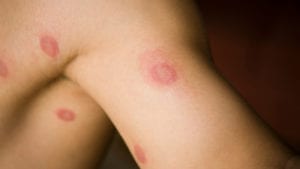Ringworm is a fungal infection of the superficial layers of the skin, hairs and nails. The fungi responsible for ringworm belong to a specialised group known as dermatophytes, and these can cause disease in both man and animals. Some species of dermatophytes will only infect man, or only infect certain animals, whereas others can be spread from animals to man.
In cats, one type (species) of dermatophyte called Microsporum canis is responsible for almost all ringworm infections, and this species in addition to being infectious to both cats and dogs, will also readily infect man.
The most common clinical sign associated with ringworm infection is one or more areas of alopecia (hair loss) which occurs due to the increased fragility of infected hairs. Most typically, infection will produce a discrete irregular or circular patch of hair loss, accompanied by variable scaling, crusting, thickening and reddening of the skin. However, infection may sometimes cause other signs including generalised disease where a much larger area of the body is affected often with patchy hair loss.
Diagnosis of ringworm infection is usually straightforward, although the disease has to be distinguished from a variety of other possible causes of hair loss. When hairs infected by Microsporum canis are examined under ultra-violet light (a Wood’s lamp), they often emit an apple-green fluorescence, and this is a simple and rapid test for the presence of this particular dermatophyte. However, not all dermatophytes cause fluorescence of infected hairs, and contamination of the hairs with other substances can also sometimes result in non-specific fluorescence. Confirmation of the diagnosis is therefore important, and is made by microscopic examination of infected hairs and/or culture (isolation) of the fungus from hair samples submitted to a laboratory. Results from the latter test may take up to three weeks.
Although in many cats, ringworm is a self-limiting infection (with resolution typically taking 3-5 months), treatment of the disease is always indicated to minimise the risk of spread of infection to humans (particularly children) and to others cats (and dogs).
Two forms of treatment can be used for cats with ringworm – topical therapy (application of creams, ointments or shampoos) and systemic therapy (administration of anti-fungal drugs by mouth). In addition, attention must also be given to cleaning the environment.
Occasionally, topical therapy is used alone for treatment of ringworm, but more commonly it is used in combination with systemic therapy, or systemic therapy may be used alone. Various creams and ointments are available to apply to localised areas of the skin affected by ringworm, or if there is more generalised disease your veterinary surgeon may advise the use of a shampoo. It is extremely important only to use preparations that have been specifically provided by, or recommended by your veterinary surgeon for topical treatment of cats. For example Sebolyze or Sebolux are safe antifungal shampoos that can be used on cats.
For most cases of ringworm, effective treatment will require administration of an oral anti-fungal drug. The most widely used drug for this purpose is griseofulvin, although newer alternative drugs are now available. The response of individual cats to treatment varies, and it is important that therapy is not stopped too early to avoid recurrence of the disease. In most cases this means that cats must be treated for a minimum of six weeks, and in some cases much longer therapy is required. If there is more than one cat in the household, it is possible either to try and separate infected from non-infected cats and just treat the infected ones, or in some situations it may be preferable to treat all of the cats – your veterinary surgeon will be able to advise you regarding your own circumstances.
Hairs infected with ringworm contain numerous microscopic fungal spores which can be shed into the environment. Infection of other animals and humans can therefore occur either by direct contact with an infected cat, or through the environmental contamination with fungal spores. In addition to minimising direct contact with an infected cat, it is therefore also important to attempt to keep the environment free of spores. Topical treatment of affected skin, and clipping of infected hairs (with careful disposal) may help to reduce environmental contamination, and it is also worthwhile considering restricting the cat to certain rooms of the house that are easy to clean. Thorough vacuum cleaning of rooms where the cat has access to is the best way to minimise environmental contamination, and this should be done as frequently as is possible (e.g. daily or every other day). In addition, the use of diluted bleach is recommended in areas that can be readily disinfected.
The vast majority of cats, if treated appropriately, will recover from ringworm infection within a few weeks. While the appearance of the lesions may not change much during the first week or so of treatment, some response (improvement) should be evident within 2-3 weeks. Occasionally, despite appropriate treatment the infection persists, and in this situation your veterinary surgeon may have to try alternative anti-fungal drugs.
Ringworm can be transmitted quite readily to humans (particularly children) and it is therefore important to take appropriate steps to minimise exposure to the fungus while the cat is being treated (see ‘Environmental Cleaning’). If any humans in the house develop skin lesions (small patches of skin thickening and reddening, or patches of hair loss) early medical attention should be sought. Ringworm in humans generally responds very well to treatment using topical creams or lotions.

